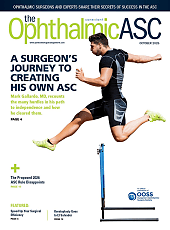
Mikhail Boukhny, MS, PhD, is the senior vice president of research and development at BVI Medical, a global ophthalmic device company. Mr. Boukhny has 30 years of leadership experience in surgical ophthalmology. Most recently, he led Carl Zeiss MediTec Surgical Research and Development, ophthalmology. Prior to that, Mr. Boukhny led Alcon’s surgical instrumentation Research and Development in cataract, vitreoretinal, refractive and diagnostics areas. He holds more than 70 patents.
Ophthalmology Management: Last year, BVI launched Serenity and Serenity Toric Premium Monofocal IOLs. Can you tell us more about these IOLs?
Mikhail Boukhny: These nondiffractive, aspheric intraocular lenses (IOLs) are the second generation of BVI Medical’s IsoPure family that were first introduced in 2019. Using patented Isofocal optic technology to balance depth of focus and image quality, these lenses provide far vision equal to a monofocal but with good intermediate vision up to 66 cm.
The Serenity series maintains the simplicity of a monofocal IOL while incorporating Isofocal technology to deliver spherical aberration correction across the entire optic diameter, along with the ability to customize the level of spherical aberration per dioptric power. The toric model benefits significantly from the maneuverability of the double C-loop POD platform. Exclusive to BVI, the platform allows the IOL to be rotated clockwise or counterclockwise to align the cylinder with the axis. For astigmatic patients, the POD platform delivers a toric IOL that remains stable in the capsular bag, with outcomes accurately predicted by BVI’s toric calculator.
Surgeons are very familiar with the traditional C-loop haptics, where they can only rotate the IOL in 1 direction. However, the BVI platform is symmetric and therefore easier for surgeons to use because it can be rotated manually in both directions. If you are not actively manipulating the lens, it will resist rotating in either direction, which is critical for astigmatism management.
Additionally, although monofocal lenses are wonderful in terms of vision sharpness at a distance, they have many limitations when it comes to intermediate vision or being able to read. The Isofocal technology is clinically virtually identical to the sharpness at distance. In terms of sharpness of vision or contrast sensitivity, there’s almost no clinically discernible reduction. Also, we’ve seen that many patients possess functional reading. This is not something we counted on, but that is the feedback we have received from the surgeons who have used it.
Serenity and Serenity Toric will have full commercial availability in CE-accepting markets in 2025. BVI hopes to bring this technology to the United States.
OM: BVI recently launched EyeXchange Solutions. Can you tell us more about this?
MB: EyeXchange Solutions connects experienced and emerging surgeons across cataract, glaucoma, and retina specialties to share insights, refine techniques, and address complex cases. In a swiftly moving field, EyeXchange Solutions facilitates insights to surgeons to navigate complex cases, refine techniques, and engage in meaningful discussions about the future of ophthalmology. By connecting experienced professionals with younger generations of surgeons, the platform fosters a continuous exchange of perspectives and practical skills.
OM: Can you discuss other developments at BVI?
MB: We have several products in the pipeline across the entire spectrum of surgical ophthalmology. This includes phaco, vitreoretinal, and glaucoma capital equipment, all of which are in active development. In addition, we are also looking into viscoelastics. Our plan is to deliver across all of these platforms globally, including the United States.
Another initiative we are working on is reducing our environmental footprint, implementing measures to minimize surgical waste. This includes making packaging smaller or more sustainable, or customizing what we are bringing to the surgery centers. We are absolutely happy to customize to what surgeons need and minimize packaging, which will help to not only reduce the costs but also reduce the impact it has on the overall ophthalmic industry and health care footprint on the environment.
We are very much in tune with what surgeons and patients need in the United States as well as globally. And this comes not just in terms of patient benefits, but ways we can make surgeons and their staff’s lives easier. I see my role as providing surgeons and patients with choices. OM








